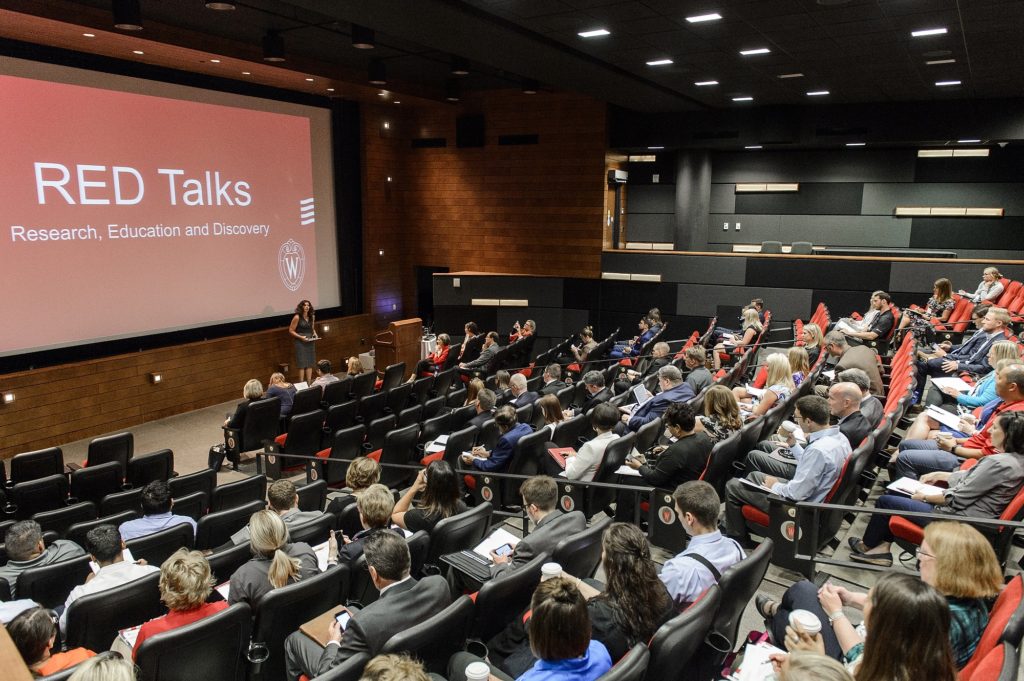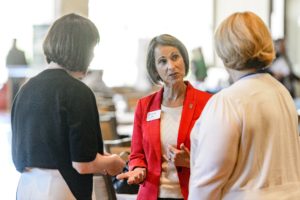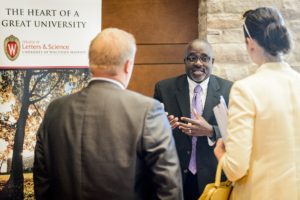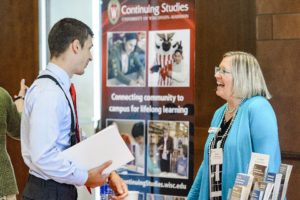
A series of talks, titled RED Talks, are presented by UW-Madison faculty and staff during the Office of Corporate Relations (OCR) Day On Campus event held in Varsity Hall in Union South at the University of Wisconsin-Madison on Aug. 23, 2017. (Photo by Bryce Richter / UW-Madison)
Representatives from 88 businesses visited the University of Wisconsin–Madison campus on Aug. 23 to learn how to get ahead by tapping UW–Madison resources.
Some of the attendees already work with the university to recruit employees, partner on research, or license products and processes, while others are just getting started.

Susan Labelle (center), managing director of the Office of Corporate Relations, talks with attendees. (Photo by Bryce Richter / UW-Madison)
“This biennial event is the only time that businesses are invited to campus for a daylong overview of the many ways they can work with the schools, colleges and other units at UW–Madison to help achieve their business goals,” says Susan LaBelle, managing director of the Office of Corporate Relations, which hosted the UW–Madison Business Engagement Day on Campus.
Bemis Company, headquartered in Neenah, is a multinational packaging firm with more than 17,000 employees, including 130 UW–Madison alumni.The day looked both backward and forward, adds LaBelle, with representatives of six companies describing the benefits of existing partnerships. “It’s exciting to have companies on hand today to share their success stories, just as others are exploring what a future UW–Madison partnership could look like. Both of these perspectives capture the spirit of why we host this event.”
“In a business with constant change, the need for engineering expertise is likely to grow,” says Kevin Nelson, a Bemis senior fellow and UW–Madison chemical engineering graduate. “From a material science and process development aspect, our business continues to evolve.

Duane Cooper (center), student services coordinator in the College of Letters and Science Internship Center, talks with attendees. (Photo by Bryce Richter / UW-Madison)
“We need to be a lot more sophisticated, because our customers and their customers are more sophisticated. Consumers not only want things to be perfect, to taste good and be healthy, they want them as natural as possible.”
Registrants for the Day on Campus ranged from human resource managers to CEOs and hailed from regional companies and global corporations. “UW-Madison is a complex organization with enormous capabilities, including students, faculty and staff, and we know that even businesses with longstanding relationships gained a better understanding of the breadth and depth of our ability to create mutually beneficial relationships,” LaBelle says.Bemis has deep connections to campus, Nelson says. “In my tenure, three chairs have been UW–Madison grads. There is a critical recognition by senior management that the University of Wisconsin–Madison is important, for people and for science.”
A series of presentations highlighted opportunities for businesses to engage with campus, including areas that might not be immediately apparent — such as math, psychology and the arts. Offering an example, Jonathan Martin, a professor of atmospheric science, described his studies of shortening winters over the past half-century.
“Could I tell Lands’ End on, say, Feb. 21 that there is a 60 percent chance that this is the end of winter?” he asked. Armed with that kind of prediction, “they might want to mount some sales now to get rid of excess inventory. That could save them some money.”

Barbara Nehls-Lowe, senior outreach specialist in the Division of Continuing Studies, talks with one of many corporate representatives, who ranged from human resource managers to CEOs and hailed from regional businesses and global companies. (Photo by Bryce Richter / UW-Madison)
“Our R&D teams partner with professors, schools and colleges at UW–Madison, usually on projects that are farther out than three years, where we need a breakthrough or invention,” he said.Tom Falk, a UW–Madison graduate who is chairman and CEO of Kimberly-Clark Corp., gave a keynote talk on the role of education and expertise in solving corporate challenges.
A good university relationship helps buttress against complacency, Falk added. “If you spend too much time admiring your past accomplishments, you are going to be replaced by someone else who wants your position.
“At Kimberly-Clark, we run out of people long before we run out of money or ideas, and so the stream of talent is critically important. Our single biggest recruiting relationship is at the University of Wisconsin, and 6 percent of salaried employees in the United States come from here.”
Recruiting from diverse populations at UW–Madison was one inducement for Len Devaisher, Wisconsin regional CEO for Old National Bank, but he offered other reasons to attend.
“There has never been a time here at this university where I did not walk away realizing that something more is happening here. I don’t want to be just a bank for clients, particularly business clients. I want to add more value, to make connections. There are resources here that could benefit my clients.”
